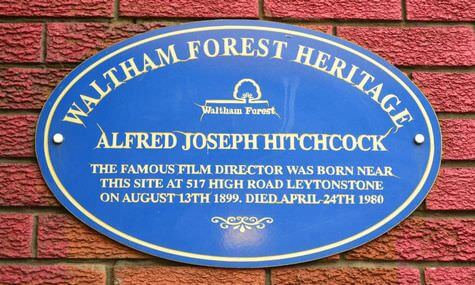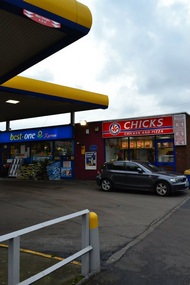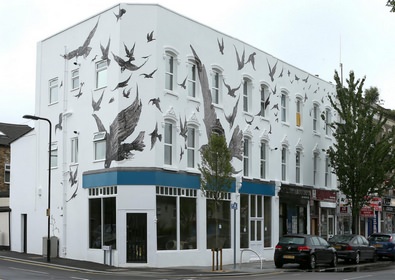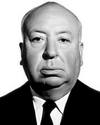Alfred Hitchcock
517 Leytonstone High Road
Intro
In 1896, together with his wife and two children, William Hitchcock moved from 29 Louise Road to 517 Leytonstone High Road. The reason was both business-driven as well as personal. In the new house on the ground floor, he quickly set up his (soon to prosper) grocery shop, and first floor was where the family lived. Alfred Hitchcock was born in that house.
Telephone lines came to Leyton in 1892, but Hitchcock family got their personal line installed in 1904. To call them, one had to dial 'Wanstead 569'.
Building history
Come 1545, Leytonstone made its debut on maps of London and its surrounding areas, but the name betrays a much older history behind the place. Rewinding the clock further until Christ wasn't born yet and then some, a Roman 10th Legion (which was temporarily stationed in the area) has left a distance marker, a stone. Leyton Stone.
Fast forward to 1880 and constructions started swarming certain area of High Road, grass fields and farmland landscape gave place to houses. That process lasted for 40 years after which there was no more room for nature directly by the road.
It is unknown when exactly was the 517 High Road house built. When William Hitchcock moved there, most of its surrounding area was already urbanized.
Area after Hitchcocks and now

In 1907, Hitchcock family moved for the last time in William's life. The destination was Salmon Lane, Limehouse. In 1911, Edward Henry Mickelborough and his family were running a business at 517 High Road Leytonstone and it was the same line of work - groceries and fruits.

It is unknown if Mickelborough directly took over from William, but since it has only been 4 years, it is fair to assume that was the case. What makes it even more probable is the fact that his wife's brother married William Hitchcock's sister Kate in 1896.
As of 2016, of the stripe of those houses only 507 still stands and hosts RSK Tyres & Wheels, a small shop that is part of a larger chain. At 517, there is now a petrol station. Until 1994, there was no sign of any kind that would indicate that this location is indeed where Alfred Hitchcock was born and spent his childhood. That changed in 1994 when the Waltham Forest Heritage Commission ordered creation of a plaque whose pictures you can see below. Barry Foster was an actor who unveiled that plaque in August 1994. He knew Alfred personally, having played Robert Rusk in the great director's 1972 movie Frenzy.

There is another reminder of who was born and raised in the area and this one is much harder to miss. In 2014, the city of London distributed £9 million among local authorities as part of a program to renew the streets and make them more attractive.
Part of those funds went to Waltham Forest Council and they hired Mateusz Odrobny (painter and graphic designer from Poland) and Anna Mill (illustrator) to paint the walls of a building right by the petrol station.
The area was chosen precisely because Alfred Hitchcock lived there and the theme had to relate to the director. Birds were chosen as they are his trademark.
As Odrobny was finishing his work on the last day of painting, he decided that somewhere there needs to be Alfred's portrait and he put his face inside the eye of the biggest bird.
Above, you can see the result of the work of Mill and Odrobny. Leytonstone received £283,000 in total for the renovations and 4 other key sites were also addressed.
Other places in the area
Sir Alfred Hitchcock Hotel
Located at 147 Whipps Cross Road, the hotel is a semi-tribute to the great director. Inside, there are his pictures on the walls, but not much besides them makes this place a homage. For the most part, it is an ordinary hotel, pub and a restaurant in one place. The business doesn't seem to be family-related, but on the other hand nobody is suing them over cashing in on a famous name, so maybe the owners are connected to the Hitchcock family in some way. Here's a link to their website.
Leytonstone Mosque
It is no surprise that a mosque can be found near Alfred Hitchcock's place of birth, as at the moment of writing this article, there are 422 mosques in London, so there is bound to be one close no matter in which part of the city someone lives. This one was opened in 1976 when Muslim population there became big enough that they needed a local place of worship so they do not have to travel to remote locations. Since then, it has expanded many times to address the ever-growing Muslim population in the area. It is located on Dacre Road.
St. Patrick's Cemetery
A short walk from Hitchcock's birthplace lies the St. Patrick Cemetery where the director's both parents, sister and at least 2 other family members are buried.
McDonald's & Tesco
what better motivation do you need to visit Leytonstone?
Famous people from Leytonstone
King Harold
It is said that together with his brother Tostig, Harold Godwinson lived in Leytonstone for a while. That must have happened before his coronation, as from that point problems started appearing one after another. Mere 9 months later, the freshly appointed king died in battle. His executioner - William the Conqueror.
David Beckham
Born at Whipps Cross University Hospital, David spent his entire childhood living with his parents in Leytonstone. His first football club was a local team Leyton Orient in the neighbouring Leyton. Close to where the footballer was born, but not nearly as close as Hitchcock's original house was - it is a 10-minutes-by-foot distance!
Fanny Cradock
Famous person, but only to the older British generations. Starting her career by making cooking shows in theaters (as weird as that sounds), she then broke through to TV and got her own cooking show on BBC which gave her a celebrity status. From there, she spread her wings into many other shows, most of them not cooking-related.
Derek Jacobi
...or rather sir Derek Jacobi, as the actor was knighted in 1994 for his huge impact on cinema and on theater. He is most famous for his fantastic, albeit supporting, portrayal of senator Gracchus (a true historical figure) in the amazing movie Gladiator. He boasts more than 100 films to his credit, not to talk about his hundreds of stage appearances.
Damon Albarn
Mostly known as the lead singer of Blur - writers of such pieces as "Song 2" and "Girls & Boys". Albarn has been graced with highly recognizable voice, but before we got to know it, he tried his luck as... a mime! His collaboration with Kid Koala is another great piece of music worth knowing. Damon wasn't born in Leytonstone, but his family moved there when he was young and so he grew up there.
Tony Robinson
Another name that is probably mostly known among the Brits, as Robinson's specialty is starring in TV shows, of which many do not see the light of day outside Great Britain. Also active politically (a member of Labour Party), privately he is a fan of a football club Bristol City - probably not something worth bragging about in London.
Trivia
- Hitchcock was not allowed to participate in business when he was young, but since the shop was below their apartments, he had plenty of contact with it anyway.
- Since the director was just 7 to 8 years old when the family moved to another location, Alfred didn't remember much of his birthplace. In one interview, he said the only clear memory of it was
the Saturday night when the first electric tram made its maiden journey
down the Leytonstone High Road. That debut ride happened in December 1906. - Leytonstone Festival is an annual event, always lasting many days and covering huge range of events: concerts, art classes, kitchen classes, history presentations and then some. They have a website with all the details.
- Leytonstone got gas pipes installed in 1857 by West Ham Gas Co. In 1901, for lighting purposes gas started to make room for electricity which proved much better and safer for the job. Since 1909, entire Leytonstone was lit by electricity.
- During World War II, Leytonstone was heavily hit by German bombs for extended periods of time. Between 7th October 1940 and 6th June 1941 (part of London Blitz), 42 bombs were dropped. Here is a detailed bombardment map. From June 1944 until August/September, there was another period of intense Leytonstone bombardment.


